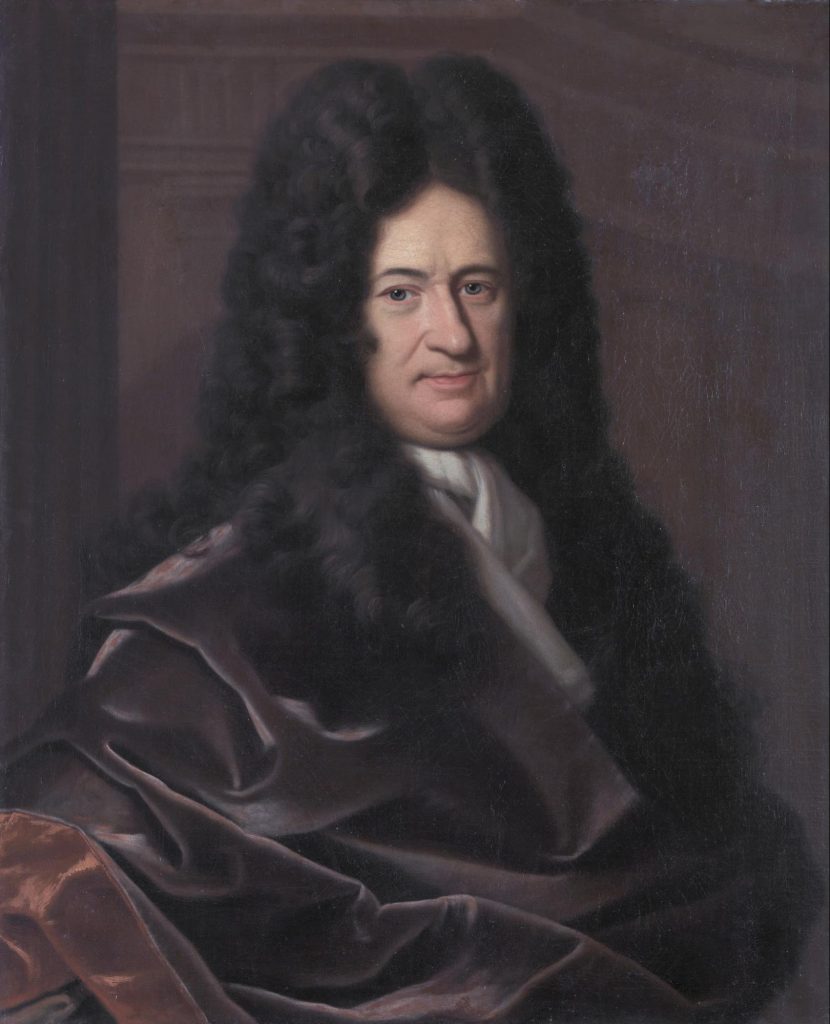Leibniz Rule is the rule defined for derivative of the antiderivative. As per the Leibniz rule, the derivative on the \(n^{th}\) order of the product of two functions can be expressed with the help of a formula.
German philosopher and mathematician Gottfried Wilhelm Leibniz used the symbols \(dx\) and \(dy\) to represent infinitely small (or infinitesimal) increments of x and y, respectively, just as \(\Delta x\) and \(\Delta y\) represent finite increments of \(x\) and \(y\), respectively.

Gottfried Wilhelm von Leibniz invented the calculating machine in 1671, which was a significant advance in mechanical calculating. The rules for calculus were first laid out in Gottfried Wilhelm Leibniz’s 1684 paper.
Index
Leibniz Theorem
Leibniz rule basically generalizes the product rule. It states that u and v are 
\({(uv)’}^{n} = {\sum^{n}_{i=0}} ^nC_i {u’}^{(n-i)} {v’}^i\)
On substituting n=1 in this formula we get product rule
\((uv)’ = u’v + uv’\)
Note: Another similar rule in calculus is quotient rule.
Derivation
Let us consider two functions \(u(x)\) & \(v(x)\), and they have the derivatives upto the \(n^{th}\) order.
Now, the first order of derivative can be written as
\((uv)’ = u’v + uv’\)
Now, the second order of derivative will be
\((uv)” = ((uv)’)’ = (u’v + uv’)’\)
= \(u”v + u’v’ + u’v’ + uv”\)
= \(u”v + 2(u’v’) + uv”\)
And the third derivative will be,
\((uv)’’’ = (uv)^{’^3}\)
= \((u”v + 2(u’v’) + uv”)’\)
= \(u’’’v + u’’v’ + 2u’’v’ + 2u’v’’ + u’v’’ + uv’’’\)
= \(u’’’v + 3u’’v’ + 3u’v’’ + uv’’’\)
Now, taking the above in consideration we can find an formula for \(n\) terms.
\((uv)’^{n} = \sum_{i = 0}^{n} u^{(n-i)}v^i\)
= \((u”v + 2(u’v’) + uv”)’\)
= \(u’’’v + u’’v’ + 2u’’v’ + 2u’v’’ + u’v’’ + uv’’’\)
= \(u’’’v + 3u’’v’ + 3u’v’’ + uv’’’\)
Now, taking the above into consideration, we can find a formula for \(n\) terms.
\({(uv)’}^{n} = {\sum^{n}_{i=0}} ^nC_i {u’}^{(n-i)} {v’}^i\)
This formula is known as the Leibniz Rule.
Proof
This formula can be proved by Principle of Mathematical Induction.
Let us consider two functions \(u(x)\) & \(v(x)\), and they have the derivatives upto the \((n+1)^{th}\) order.
\({y’}^{(n+1)} = ({y’}^n)’\)
= \([ {\sum^{n}_{i=0}} ^nC_i {u’}^{n – i} {v’}^{i}]’\)
= \([ {\sum^{n}_{i=0}} ^nC_i {u’}^{n – i + 1} {v’}^{i}] + … (i)\)
\([ {\sum^{n}_{i=0}} ^nC_i {u’}^{n – i} {v’}^{i + 1}] … (ii)\)
Now, let us combine the summation on right side in a single sum, as both holds the same limits.
Let \(\exists m\) such that \(1 \leq m \leq n\).
So, when \(i = m\), (i) becomes
\(^nC_m {u’}^{n – m + 1} {v’}^{m}\) … (iii)
And, the second term \(i + 1 = m\) (or) \(i = m – 1\), becomes
\(^nC_{m-1} {u’}{n – (m – 1)} {v’}^{(m- 1) + 1}\)
\(\Rightarrow ^nC_{m-1} {u’}^{n – m + 1} {v’}^{m} … (iv)\)
Adding (iii) & (iv) we get
\(^nC_m {u’}^{n – m + 1} {v’}^{m} + ^nC_{m-1} {u’}{n – m + 1} {v’}^{m} = [^nC_m +^nC_{m-1}] {u’}^{n – m + 1} {v’}^{m}\)
From combinatorics, we use addition and get;
\([^nC_m +^nC_{m-1}] {u’}^{n – m + 1} {v’}^{m} = [^{n + 1}C_{m}] {u’}^{n – m + 1} {v’}^{m} … (v)\)
As, we can see that the values of \(m\) will change from \([1, n]\) for \(i\), but it will not cover the values for \(i = 0\) in (i) & \(i = 1\) in (ii) cases.
Hence,
When \(i = 0\) in (i) \(\Rightarrow ^nC_0 {u’}^{n – 0 + 1} {v’}^{0} = {u’}^{n + 1} {v’}^{0} … (vi)\)
& \(i = n { \mbox{ since } ^nC_1 = ^nC_n}\)
in (ii) \(\Rightarrow ^nC_i {u’}^{n – i} {v’}^{i + 1}] = {u’}^{0} {v’}^{n+1} … (vii)\)
Hence, from the \((n + 1)^{th}\) derivative we got the result by adding (v), (vi) & (vii)
\(y^{n+1} = {u’}^{n + 1} {v’}^{0} + {\sum^{n}_{i=0}} [^{n + 1}C_{m}] {u’}^{n – m + 1} {v’}^{m} + {u’}^{0} {v’}^{n+1}\)
\(\Rightarrow {\sum^{n}_{i=0}} ^{n+1}C_m {u’}^{n + 1 – m} {v’}^{m}\)
Hence Proved, for \((n + 1)\) terms. Hence the theorem gets proved.
Applications of Leibniz Rule
The second Reynold’s Transport Theorem is deduced from the application of the Leibniz Rule for \(\mathbb{R}^3\) with Reynold’s first Transport theorem.
The Leibniz formula gives the derivative on \(n^{th}\) order of the product of two functions and works as a connection between integration and differentiation.
Examples on Leibniz Rule
Question 1. If \(f(x) = sin x\) and \(g(x) = cos x\)
Find the coefficient of \(sin^{11} (2x)\) of function \(f(x)g(x)\).
Solution. Let \(h(x )= y = f(x)g(x)\)
\(y’^{22} = {\sum^{n}_{i=0}} ^{22}C_i {f(x)}’^{(22 – i)} {g(x)’}^{i}\)
\(y’^{22} = ^{22}C_0 {f(x)’}^{(22 – 0)} {g{x}’}^0 + ^{22}C_1 {f(x)’}^{(22 – 1)} {g(x)’}^{1} ….^{22}C_{22} {f(x)’}^{(22 – 22)} {g(x)’}^{22}\)
\(\Rightarrow ^{22}C_0 {sin’}^{(22 – 0)}(x) {cos’}^{0}(x) + ^{22}C_1 {sin’}^{(22 – 1)} (x) {cos’}^{1}(x) ….^{22}C_{22} {sin’}^{(22 – 22)}(x) {cos’}^{22}(x)\)
Now for \(sin^{11} (2x)\) will be the \(12^{th}\) term of the sequence
Therefore, \(^{22}C_{11} sin^{22 – 11}(x) cos^{11}(x)\)
\(\Rightarrow ^{22}C_{11} \frac{1}{2} sin^{11}(2x)\)
Therefore the coefficient of \(sin^{11}(2x)\) is \(^{22}C_{11} \frac{1}{2}\).
Question 2. Let \(f(x) = \sqrt{1 – x^2}\) and let \({y’}^{n}\) denote the \(n^{th}\) derivative of \(f(x)\) at \(x = 0\), then find the value of \(6{y’}^{1} {y’}^{2} + 2{y’}^{3}\)
Solution. Let \(y = f(x) = \sqrt{1 – x^2}\)
We can rewrite the function as
\(y^2 = 1 – x^2\)
Differentiating both sides upto third derivative using Leibniz rule
\((y^2)’^{3} = ^3C_0 {y’}^{3}y + ^3C_1 {y’}^{2} {y’}^{2} + ^3C_2 {y’}^{1} {y’}^{2} + ^3C_3 {y’}^{0} {y’}^{3}\)
\({(y^2)’}^{3} = 2{y’}^{3} + 6{y’}^{2} {y’}^{1} … (i)\)
& \({(1 – x^2)’}^{3} = 0 … (ii)\)
From (i) & (ii) we get,
\(2{y’}^{3} + 6{y’}^{2} {y’}^{1} = 0\)
FAQs
The Leibniz formula expresses the \(n^{th}\) order of derivative of a product of two functions.
Leibniz uses the symbols \(dx\) and \(dy\) to represent infinitesimal increments of \(x\) and \(y\), respectively, and as \(\Delta x\) and \(\Delta y\) represent finite increments of \(x\) and \(y\), respectively.
The rule was given by Gottfried Wilhelm Leibniz
